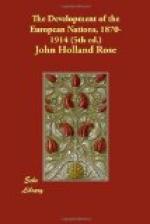The Sultan, Abdul Aziz, during his fifteen years of rule had increasingly shown himself to be apathetic, wasteful, and indifferent to the claims of duty. In the month of April, when the State repudiated its debts, and officials and soldiers were left unpaid, his life of luxurious retirement went on unchanged. It has been reckoned that of the total Turkish debt of LT200,000,000, as much as LT53,000,000 was due to his private extravagance[99]. Discontent therefore became rife, especially among the fanatical bands of theological students at Constantinople. These Softas, as they are termed, numbering some 20,000 or more, determined to breathe new life into the Porte—an aim which the patriotic “Young Turkey” party already had in view. On May 11 large bands of Softas surrounded the buildings of the Grand Vizier and the Sheik-ul-Islam, and with wild cries compelled them to give up their powers in favour of more determined men. On the night of May 29-30 they struck at the Sultan himself. The new Ministers were on their side: the Sheik-ul-Islam, the chief of the Ulemas, who interpret Mohammedan theology and law, now gave sentence that the Sultan might be dethroned for mis-government; and this was done without the least show of resistance. His nephew, Murad Effendi, was at once proclaimed Sultan as Murad V.; a few days later the dethroned Sultan was secretly murdered, though possibly his death may have been due to suicide[100].
[Footnote 99: Gallenga, The Eastern Question, vol. ii. p. 99.]
[Footnote 100: For the aims of the Young Turkey party, see the Life of Midhat Pasha, by his son; also an article by Midhat in the Nineteenth Century for June 1878.]
We may add here that Murad soon showed himself to be a friend to reform; and this, rather than any incapacity for ruling, was probably the cause of the second palace revolution, which led to his deposition on August 31. Thereupon his brother, the present ruler, Abdul Hamid, ascended the throne. His appearance was thus described by one who saw him at his first State progress through his capital: “A somewhat heavy and stern countenance . . . narrow at the temples, with a long gloomy cast of features, large ears, and dingy complexion. . . . It seemed to me the countenance of a ruler capable of good or evil, but knowing his own mind and determined to have his own way[101].” This forecast has been fulfilled in the most sinister manner.
[Footnote 101: Gallenga, The Eastern Question, vol. ii. p. 126. Murad died in the year 1904.]
If any persons believed in the official promise of June 1, that there should be “liberty for all” in the Turkish dominions, they might have been undeceived by the events that had just transpired to the south of the Balkan Mountains. The outbreak of Moslem fanaticism, which at Constantinople led to the dethronement of two Sultans in order to place on the throne a stern devotee, had already deluged with blood the Bulgarian




